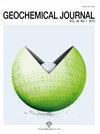Equilibrium sulfur isotope fractionations of several important sulfides
Jixi Zhang
求助PDF
{"title":"Equilibrium sulfur isotope fractionations of several important sulfides","authors":"Jixi Zhang","doi":"10.2343/geochemj.2.0623","DOIUrl":null,"url":null,"abstract":"Copyright © 2021 by The Geochemical Society of Japan. sulfur isotope analyses have been applied to ore deposits; the pioneers of this subject area are Kulp et al. (1956) and Jensen (1957, 1959), among others. At present, sulfur isotopes are used in the fields of geology (e.g., Shanks et al., 1981), biology (e.g., Rees, 1973; Habicht and Canfield, 1997; Habicht et al., 1998; Bolliger et al., 2001; Brüchert et al., 2001; Detmers et al., 2001) and environmental science (e.g., Harris et al., 2013), etc. Notably, research on the mass-independent fractionation of sulfur is currently the most active topic in the field of sulfur isotope geochemistry (Farquhar et al., 2000, 2001, 2013; Savarino et al., 2003; Subrata et al., 2013). It is well known that equilibrium isotope fractionation can be used to estimate the formation temperature of minerals in geological systems (Urey and Greiff, 1935; Urey, 1947). Isotope geochemistry mainly focuses on the change in the isotope ratio between different species rather than on their absolute abundances. The general rule for isotope fractionation is that heavy isotopes tend to form more stable chemical bonds; for example, M34S is more stable than M32S (M stands for metal cations). When considering kinetic isotope effects, molecules with different isotopes have different reaction rates (O’Neil, 1986). In the case of sulfur, 34S/32S is the key point of interest. In most cases, isotope fractionation is relatively small, and most of the time, the δ notation is used to express isotope fractionation. In this article, only the ratio of 34S/32S is Equilibrium sulfur isotope fractionations of several important sulfides","PeriodicalId":12682,"journal":{"name":"Geochemical Journal","volume":"6 1","pages":""},"PeriodicalIF":1.0000,"publicationDate":"2021-01-01","publicationTypes":"Journal Article","fieldsOfStudy":null,"isOpenAccess":false,"openAccessPdf":"","citationCount":"6","resultStr":null,"platform":"Semanticscholar","paperid":null,"PeriodicalName":"Geochemical Journal","FirstCategoryId":"89","ListUrlMain":"https://doi.org/10.2343/geochemj.2.0623","RegionNum":4,"RegionCategory":"地球科学","ArticlePicture":[],"TitleCN":null,"AbstractTextCN":null,"PMCID":null,"EPubDate":"","PubModel":"","JCR":"Q3","JCRName":"GEOCHEMISTRY & GEOPHYSICS","Score":null,"Total":0}
引用次数: 6
引用
批量引用
Abstract
Copyright © 2021 by The Geochemical Society of Japan. sulfur isotope analyses have been applied to ore deposits; the pioneers of this subject area are Kulp et al. (1956) and Jensen (1957, 1959), among others. At present, sulfur isotopes are used in the fields of geology (e.g., Shanks et al., 1981), biology (e.g., Rees, 1973; Habicht and Canfield, 1997; Habicht et al., 1998; Bolliger et al., 2001; Brüchert et al., 2001; Detmers et al., 2001) and environmental science (e.g., Harris et al., 2013), etc. Notably, research on the mass-independent fractionation of sulfur is currently the most active topic in the field of sulfur isotope geochemistry (Farquhar et al., 2000, 2001, 2013; Savarino et al., 2003; Subrata et al., 2013). It is well known that equilibrium isotope fractionation can be used to estimate the formation temperature of minerals in geological systems (Urey and Greiff, 1935; Urey, 1947). Isotope geochemistry mainly focuses on the change in the isotope ratio between different species rather than on their absolute abundances. The general rule for isotope fractionation is that heavy isotopes tend to form more stable chemical bonds; for example, M34S is more stable than M32S (M stands for metal cations). When considering kinetic isotope effects, molecules with different isotopes have different reaction rates (O’Neil, 1986). In the case of sulfur, 34S/32S is the key point of interest. In most cases, isotope fractionation is relatively small, and most of the time, the δ notation is used to express isotope fractionation. In this article, only the ratio of 34S/32S is Equilibrium sulfur isotope fractionations of several important sulfides
几种重要硫化物的平衡硫同位素分馏
日本地球化学学会版权所有©2021。硫同位素分析已应用于矿床;这一学科领域的先驱是Kulp等人(1956)和Jensen(1957, 1959)等人。目前,硫同位素应用于地质学(如Shanks等,1981)、生物学(如Rees, 1973;Habicht and Canfield, 1997;Habicht et al., 1998;Bolliger et al., 2001;br chert et al., 2001;Detmers等人,2001年)和环境科学(如Harris等人,2013年)等。值得注意的是,硫的质量无关分馏是目前硫同位素地球化学领域最活跃的研究课题(Farquhar et al., 2000,2001,2013;Savarino et al., 2003;Subrata et al., 2013)。众所周知,平衡同位素分馏可以用来估计地质系统中矿物的形成温度(Urey和Greiff, 1935;尤里,1947)。同位素地球化学主要关注不同物种之间同位素比值的变化,而不是它们的绝对丰度。同位素分馏的一般规律是,重同位素倾向于形成更稳定的化学键;例如,M34S比M32S更稳定(M代表金属阳离子)。在考虑同位素动力学效应时,不同同位素的分子具有不同的反应速率(O 'Neil, 1986)。在硫的情况下,34S/32S是关键的兴趣点。在大多数情况下,同位素分馏相对较小,大多数情况下,δ符号用于表示同位素分馏。在本文中,只有34S/32S的比值是几种重要硫化物的平衡硫同位素分馏
本文章由计算机程序翻译,如有差异,请以英文原文为准。


